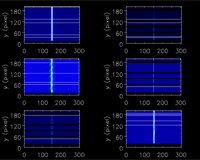First 15-baseline BETA observation achieved28 March 2014 The ASKAP team has this week achieved the first 15-baseline observation using six ASKAP antennas and the newly reconfigured hardware correlator at the Murchison Radio-astronomy Observatory (MRO) in Western Australia. These six ASKAP antennas – installed with MkI phased array feed (PAF) receivers, and associated digital electronics – is known as the Boolardy Engineering Test Array (BETA), an engineering testbed for commissioning activities that helps the team prepare for the full fit-out of ASKAP. Until now, the BETA hardware correlator was configured to operate with two simultaneous 3-antenna arrays (ASKAP Antennas 1-3-6 and 8-9-15). A recent reconfiguration of the hardware correlator combined the two 'sub-arrays' to form the 6-antenna system, creating the first stable ASKAP commissioning and testing platform for BETA. As part of commissioning and verification tests, the team has now achieved fringes on all 15 baselines for BETA, with only narrow-band 'birdies' that remain visible in the data. Each of the 15 panels (in the accompanying image) show a single baseline of the BETA 6-antenna array. The y-axis show time (in 5-second steps) and the x-axis is relative 'lag' (in 3-nanosecond steps). While the team continues to work on smoothing the data out further, these early results imply that the reconfiguration process was a success and the team can now move on to a deeper testing process, by creating images of astronomical sources. Back to Latest ASKAP News page. |
This loads a font easier to read for people with dyslexia.
This renders the document in high contrast mode.
This renders the document as white on black
This can help those with trouble processing rapid screen movements.

